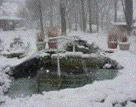 When water lilies and other vegetation in your pond are slowing their growth and starting to fade they are getting ready for dormancy. Time to start preparing our ponds for winter and our fish for their long winter’s nap. Transplanting and dividing of your pond plants should be left until foliage from marginal plants. marginal plants should be cut down after the first frost. In areas where the water lily beetle is prevalent, they love nothing better than the dying foliage of your marginal plants where they can hide for the winter.
When water lilies and other vegetation in your pond are slowing their growth and starting to fade they are getting ready for dormancy. Time to start preparing our ponds for winter and our fish for their long winter’s nap. Transplanting and dividing of your pond plants should be left until foliage from marginal plants. marginal plants should be cut down after the first frost. In areas where the water lily beetle is prevalent, they love nothing better than the dying foliage of your marginal plants where they can hide for the winter.
Do not fertilize your plants anymore. Remove and bring indoors your tropical marginal plants before the first frost. To protect your hardy water plants, lower them to the bottom of your pond unless they are planted in the rock beds of your pond. Now is the time to install a protective net over the pond if you have a lot of falling leaves. Plastic bird netting is available at most garden centers. You can insert a stick or garden rake into a potted plant to give your net a higher point, like a tent. This will allow the leaves to be swept from the net. Do not allow the net to drape into your pond. Fish and frogs can become entangled in the net. Remove the leaves regularly from both pond and net. Keep them picked up from your yard so that the wind does not blow them in the pond. Repair any damages and leaks before winter. Continue the use of benifical bacteria in your biofilters. This will help maintain good water quality during fall. Slow down feeding your fish food . Your fish do not hibernate during the winter. Their metabolism slows down as the water-cools down. Start feeding your fish only once a day until the water temperature stabilizes below 55°. DO NOT FEED THEM AGAIN UNTIL SPRING WHEN THE WATER TEMPERATURE WARMS UP ABOVE THAT POINT. Even if we have some warm days during winter, do not feed. Now your fish do not have the cover of the plants to hide from predators. Keep an eye open. The herons can still get to your fish through a net. Try some fishing line around your pond, about six inches from the ground. Crisscross the line across your pond also. A milk carton, large planter turned upside down with a hole in the side, drainage pipes or anything else that your fish can hide in will protect them from raccoons and other predators. Make sure there aren’t any rough edges for your fish to cut themselves on. Clean your filters and store any pumps or equipment you won’t use during the winter. Remember to store oil-encapsulated pumps in a bucket of water that won’t freeze to keep their seals from drying out. Place your de-icer or bubblers in the pond. Whatever method you use, remember to always keep an opening in the ice (pond) so that the gases can escape. Your fish will survive in as little as 18 inches of water as long as it does not freeze solid.

